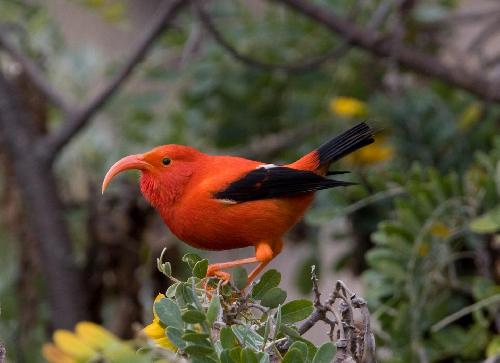Rare birds living in Hawaii's higher elevation forests may lose more than 50% of their habitat under climate shifts projected by the end of the century, according to a study published October 28, 2015 in the open-access journal PLOS ONE by Lucas Fortini from the U.S. Geological Survey and colleagues.
Scientists have observed that Hawaiian forest birds have been threatened for many years due to habitat loss and disease. The most vulnerable populations have survived in Hawaii's higher elevation forests, where native vegetation persists and cool temperatures limit mosquitos that carry diseases, like avian malaria. Scientists predict that global climate change may drive up temperatures in Hawaii, allowing mosquitos into this high elevation habitat. The authors of this study use a species sightings database, regional climate projections, and distribution models to elucidate the impacts of potential climate shifts on the ranges of 20 Hawaiian forest bird species.
Under a climate change scenario projecting moderate temperature increase and disease spread, the authors found that 10 species, including several endangered bird species, may lose more than 50% of their range. Six of these species may lose 90% or more of their current range this century. Projected range loss was smaller for several of the more widespread species, but the authors add that improved data and models are necessary to refine their future projections. Hawaiian forest birds, similarly to rare species elsewhere, have specific habitat requirements that limit the possibility of range expansion for most species.
 This is `I`iwi (Vestiaria coccinea), a Hawaiian forest bird on an endemic Māmane tree. `I`iwi is one of several species of endemic Hawaiian forest birds at risk of range collapse under climate-driven avian malaria spread. Credit: Robby Kohley
This is `I`iwi (Vestiaria coccinea), a Hawaiian forest bird on an endemic Māmane tree. `I`iwi is one of several species of endemic Hawaiian forest birds at risk of range collapse under climate-driven avian malaria spread. Credit: Robby Kohley
"As dire as these findings are, they do not mean that these bird species are doomed," said lead author Dr. Lucas Fortini, research ecologist with the USGS, "Instead, our findings indicate what may happen if nothing is done to address the primary drivers of decline: disease spreading uphill into the few remaining refuges." Ongoing conservation and restoration actions continue to be critical, but this research indicates the need to pair these efforts with new methods to deal with avian malaria and the spread of mosquitos.
source: PLOS